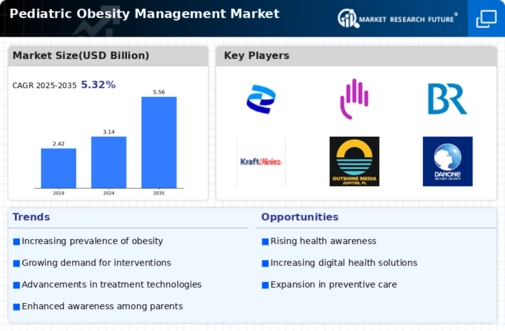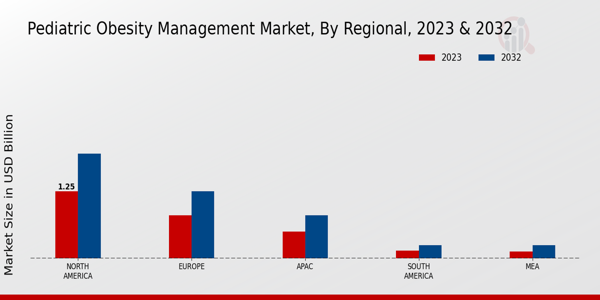Market Growth Projections
The Global Pediatric Obesity Management Market Industry is poised for substantial growth, with projections indicating a market value of 3.14 USD Billion in 2024 and an anticipated increase to 5.56 USD Billion by 2035. This growth trajectory reflects a compound annual growth rate (CAGR) of 5.33% from 2025 to 2035. Such figures highlight the increasing recognition of pediatric obesity as a critical public health issue, driving investments in research, treatment, and prevention strategies. The market's expansion is expected to be fueled by a combination of rising obesity rates, technological advancements, and supportive government policies.
Government Initiatives and Policies
Government initiatives aimed at combating childhood obesity significantly influence the Global Pediatric Obesity Management Market Industry. Numerous countries have implemented policies promoting healthier eating habits and increased physical activity among children. For instance, the U.S. Department of Agriculture has introduced programs to improve school meal standards. Such initiatives not only raise awareness but also create a supportive environment for obesity management. These efforts are expected to contribute to the market's growth, with projections indicating a rise to 5.56 USD Billion by 2035, driven by sustained governmental support and public health campaigns.
Increased Awareness of Health Risks
The growing awareness of health risks associated with pediatric obesity is a significant driver of the Global Pediatric Obesity Management Market Industry. Parents, educators, and healthcare professionals are increasingly recognizing the long-term consequences of obesity, including diabetes, cardiovascular diseases, and psychological issues. This heightened awareness is prompting proactive measures to address obesity in children. Educational programs and community initiatives are being developed to promote healthy lifestyles among families. As a result, the demand for obesity management solutions is expected to rise, further propelling market growth in the coming years.
Rising Prevalence of Pediatric Obesity
The increasing prevalence of pediatric obesity is a primary driver of the Global Pediatric Obesity Management Market Industry. According to data, approximately 18.5 percent of children and adolescents aged 2 to 19 years are classified as obese. This alarming statistic underscores the urgent need for effective management strategies. As awareness of obesity-related health risks grows, healthcare providers are increasingly focusing on preventive measures and treatment options. The market is projected to reach 3.14 USD Billion in 2024, reflecting the heightened demand for interventions aimed at combating this public health crisis.
Technological Advancements in Treatment
Technological advancements in treatment modalities are reshaping the Global Pediatric Obesity Management Market Industry. Innovations such as mobile health applications and telemedicine are facilitating personalized obesity management plans for children. These technologies enable healthcare providers to monitor patients remotely, ensuring adherence to dietary and exercise regimens. Moreover, the integration of artificial intelligence in developing tailored interventions shows promise in enhancing treatment efficacy. As the market evolves, these technological solutions are likely to attract investment and drive growth, contributing to the projected CAGR of 5.33% from 2025 to 2035.
Rising Demand for Personalized Nutrition
The rising demand for personalized nutrition is shaping the Global Pediatric Obesity Management Market Industry. Parents are increasingly seeking tailored dietary solutions that cater to their children's specific health needs and preferences. This trend is driven by a growing understanding that one-size-fits-all approaches may not be effective in managing obesity. Nutritionists and healthcare providers are leveraging genetic and metabolic information to create individualized meal plans. This shift towards personalized approaches is likely to enhance treatment outcomes and foster greater engagement among families, thereby contributing to the market's expansion.























